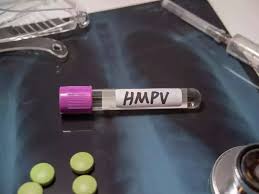What Is HMPV? Symptoms and How to Stay Safe During Human Metapneumovirus Outbreak
By Lokmat English Desk | Updated: January 6, 2025 13:36 IST2025-01-06T12:50:39+5:302025-01-06T13:36:52+5:30
After 5 years of Covid 19 scare another virus has emerged in China named HMPV. This virus is related ...

What Is HMPV? Symptoms and How to Stay Safe During Human Metapneumovirus Outbreak
After 5 years of Covid 19 scare another virus has emerged in China named HMPV. This virus is related to respiratory illnesses. The Indian Council of Medical Research (ICMR) on Monday confirmed a second positive case of Human Metapneumovirus (HMPV) virus from Karnataka. The second one is a 3-month-old female infant while the first one is an 8-month-old male infant.
What is HMPV and whom it can affect?
Human Metapneumovirus (HMPV) is a highly contagious virus that primarily targets the respiratory system, leading to a range of illnesses from mild, cold-like symptoms to more severe respiratory conditions. Although it generally causes mild illness in most healthy individuals, it poses a significant risk to vulnerable populations such as young children, the elderly, and those with weakened immune systems.
Symptoms of HMPV
The symptoms of HMPV are similar to those of other respiratory viruses and can include:
- Cough
- Runny or stuffy nose
- Fever
- Sore throat
- Wheezing or shortness of breath (in severe cases)
In more serious instances, HMPV can lead to complications such as bronchitis or pneumonia, particularly in at-risk individuals like infants, older adults, and those with chronic respiratory conditions.
Also Read: HMPV Outbreak In India: Second Positive Case Reported In Bengaluru
Transmission of HMPV
HMPV spreads through several modes of transmission:
- Respiratory droplets: These are released when an infected person coughs, sneezes, or talks.
- Direct contact: The virus can be spread by touching an infected person or surfaces contaminated with the virus.
- Airborne particles: In crowded or poorly ventilated spaces, small virus particles can linger in the air, increasing the risk of transmission.
HMPV typically circulates during the late winter and spring months in temperate regions, following a seasonal pattern.
At-Risk Populations
Certain groups of people are at higher risk for severe illness due to HMPV. These include:
- Children under five years old, especially infants
- Older adults, particularly those aged 65 and above
- Individuals with compromised immune systems or chronic respiratory conditions like asthma or chronic obstructive pulmonary disease (COPD)
For these groups, HMPV can cause more severe respiratory issues and may require more intensive care.
Diagnosis and Treatment
To diagnose HMPV, healthcare providers assess symptoms and may use laboratory tests to confirm the presence of the virus. Most cases of HMPV resolve within a week to ten days without the need for specific antiviral treatments. Supportive care is the main form of treatment, focusing on symptom management, such as:
- Hydration
- Fever control
Antibiotics are ineffective against HMPV, as it is a viral infection. However, they may be prescribed if a secondary bacterial infection occurs.
Prevention Strategies
Health authorities emphasize the following preventive measures to reduce the risk of HMPV infection:
- Frequent handwashing with soap and water
- Avoiding touching the face with unwashed hands
- Wearing masks in crowded settings, especially during seasonal outbreaks
- Maintaining good hygiene practices to prevent respiratory infections
By following these precautions, individuals can help reduce the transmission of HMPV and protect vulnerable populations.
While Human Metapneumovirus generally causes mild respiratory illness, it can pose serious health risks to certain individuals, including young children, the elderly, and those with compromised immune systems. By understanding the symptoms, transmission methods, and prevention strategies, people can help minimize the impact of HMPV, particularly during peak seasonal outbreaks, and protect those most at risk.
Open in app